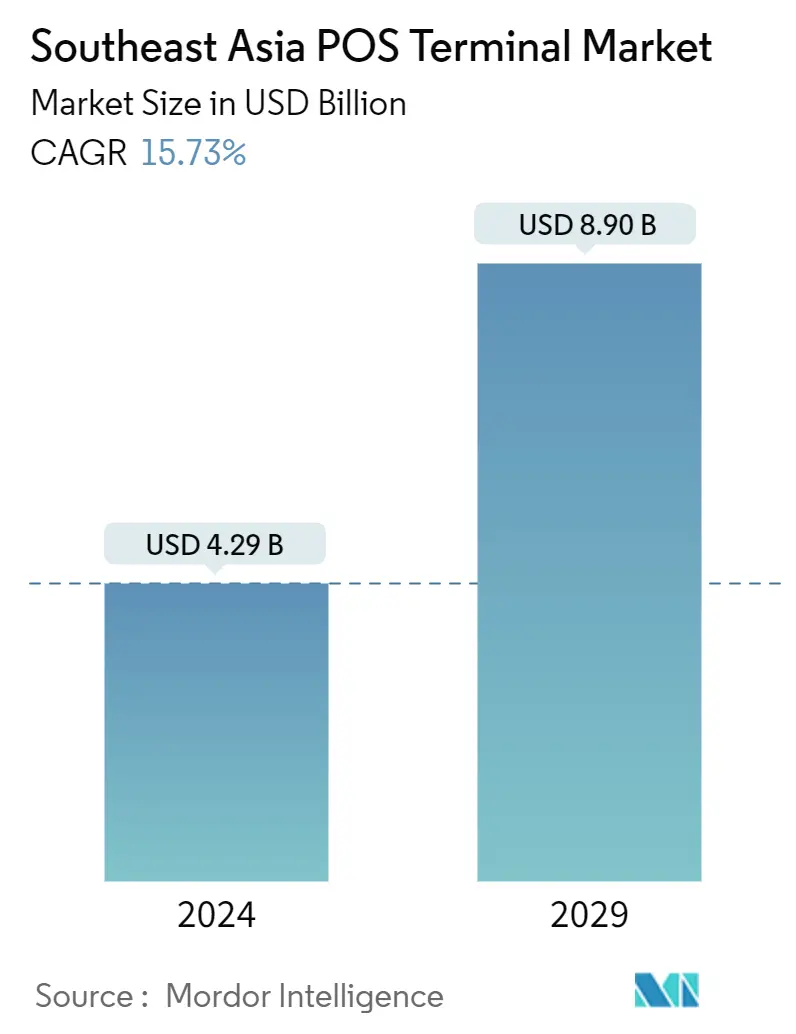Market Size of Southeast Asia POS Terminal Industry

| Study Period | 2019 - 2029 |
| Base Year For Estimation | 2023 |
| Market Size (2024) | USD 4.29 Billion |
| Market Size (2029) | USD 8.90 Billion |
| CAGR (2024 - 2029) | 15.73 % |
| Market Concentration | Medium |
Major Players
*Disclaimer: Major Players sorted in no particular order |
Need a report that reflects how COVID-19 has impacted this market and its growth?
Southeast Asia POS Terminal Market Analysis
The Southeast Asia POS Terminal Market size is estimated at USD 4.29 billion in 2024, and is expected to reach USD 8.90 billion by 2029, growing at a CAGR of 15.73% during the forecast period (2024-2029).
As a result of its ability to deliver an improved return on investment and accessibility, POS terminals have been rapidly adopted over the last few years. Over the years, the importance of point-of-sale systems in small and large enterprises has increased, facilitating transactions from the central part of the enterprise in sectors such as retail, hospitality, transport, and banking.
- POS terminals have evolved from transaction-oriented terminals to systems integrated with the company's CRM and other financial solutions. As a result, end users with business intelligence have better managed their revenue streams and inventory. Companies have replaced their traditional billing software with point-of-sale systems due to the functional benefits of advanced point-of-sale systems to ensure the growth of point-of-sale systems.
- Over the past few years, rising cases of financial crime in Southeast Asia have influenced government regulatory bodies to improve security for payment transactions. The need to use secure payment procedures is becoming increasingly essential to meet consumers' demands for safety and reliability with their digital transactions. These Regulatory Authorities have positively affected the adoption of POS terminals. Mobile POS systems have taken off as a result of rising mobility trends around the world. In the region, POS adoption rates have increased due to the introduction of cashless transaction technologies.
- The growth in terminals and face-to-face outlets is expected to be hampered by the growing e-commerce and online shopping trends and brick-and-mortar retail practices. With the possibility of cash on delivery offered by significant e-commerce platforms, a sudden surge in the adoption of mobile POS terminals was noticed.
- Due to growing customer demand for quick and easy payments, card fraud has become increasingly sophisticated. Hackers may be identified targeting the POS system's firmware to steal credit and other payment data. Point-of-sale fraud is largely caused by merchants' failure to leverage point-to-point encryption (P2PE) solutions to safeguard POS data.
- Furthermore, the COVID-19 pandemic affected how people shop, affecting various market segments. The pandemic had a significant impact on the retail industry. Increasingly, consumers are using a variety of sales channels, such as curbside pick-up, virtual consultations, contactless payments, social commerce, and online shopping. According to retail experts and consumer surveys, this new behavior will likely continue during the forecast period. The demand for point-of-sale terminals is expected to increase due to changes in consumer behavior associated with the Pandemic.
